PZ.218 Agatha
4 July 2019The lettering and numbering of fishing boats
21 July 2019Breadwinner~PZ.121 : 1925-26 / Biddy~PZ.121 : 1926-1989 [+?]
Built in 1925, for Edward James Williams, of Cliff House, Porthleven, and Thomas Kitchen Williams, of Peverell Rd., Porthleven, she was first registered as the Breadwinner~PZ.121, on July 3rd of that year as an auxiliary motor lugger.1 Working lines and nets, with an inclusive crew of four men, Edward Williams was her registered first skipper, and her dimensions made her 20.15 tons, well above the 15 ton threshold for 1st Class fishing boats.
She was not named Breadwinner for long as on October 14th 1926 she was re-named Biddy, presumably after a female family member of one of the owners. Her other details and dimensions remained the same at that time. However, in 1928 she was re-measured [when deductions for her gross tonnage were allowed for machinery space, which reduced her registered tonnage to 12.25 tons, technically making her a 2nd Class sea-fishing boat.
Sometime prior to 1932, she was photographed with other Porthleven boats, anchored in the harbour channel.
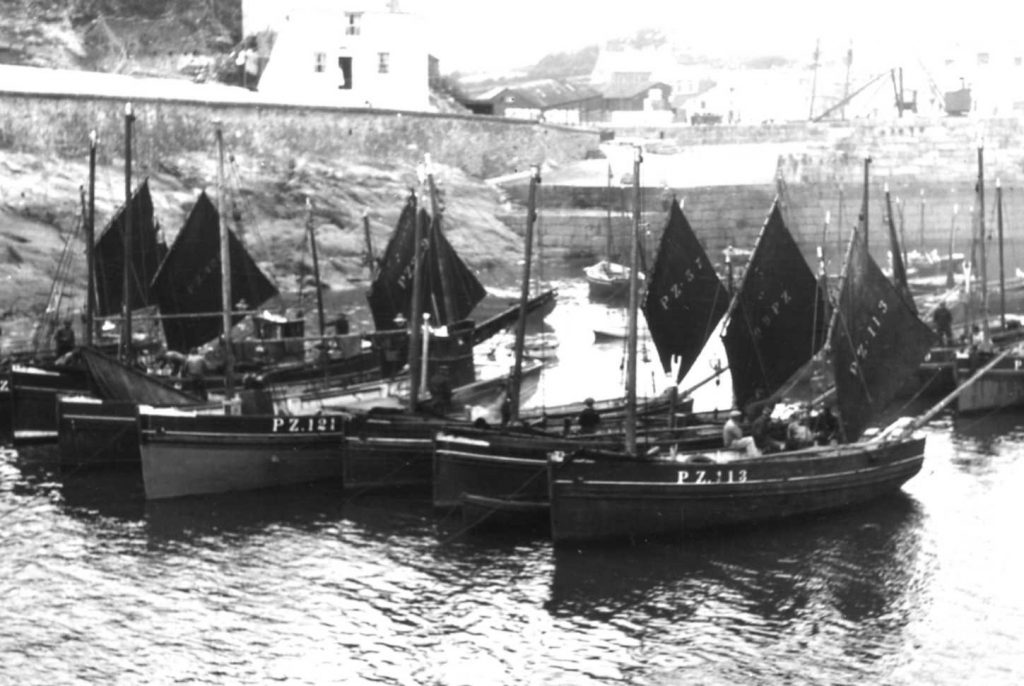
Like a number of her contemporaries, she has a wheel-house aft, and would have had wheel steering gear, instead of a heavy tiller. However, while her sailing companions have mizzen lugs, the Biddy’s mizzen is a gaff-sail, albeit furled in this shot.
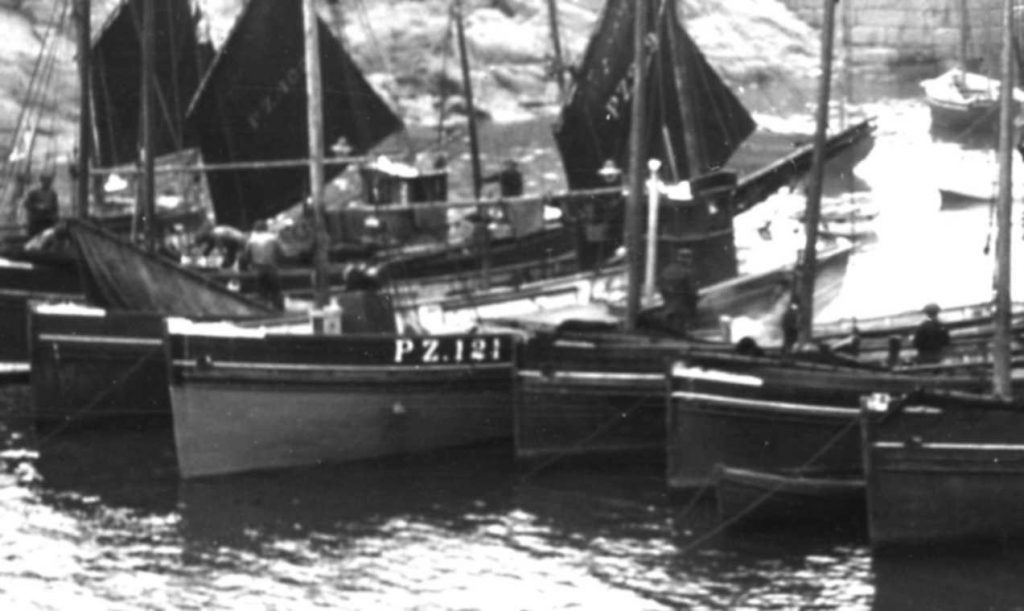
Still owned jointly by Porthleven fishermen, by July 1937 Thomas Kitchen Williams, had moved to Secluded Cottage, and Edward’s interest in the boat had been sold, or passed to Charles Garfield Eddy, of Sea View, Mount’s Road, who became her skipper on July 26th, 1937.
Porthleven based, prior to the Second World War she only made occasional landings of pilchards at Newlyn – usually late in the season. It is highly probable that during the 1930s her owners contracted with one or other of the pilchard curers at Porthleven for their season’s catch at a pre-determined price – possibly Pawlyn Bros. Only on a few odd occasions did she land pilchards in Newlyn. However, during week-ending August 14th 1939 – the eve of the war – she landed over 50 thousand pilchards. In all landing over 160,000 fish at Newlyn that last season, making £101, for nine weeks work.2
On June 16th, 1940, Biddy was one of more than 30 Penzance & St. Ives registered fishing boats – recorded as then being in Falmouth waters – called in for the Dunkirk evacuation. But that gallant episode was all over before most of the Cornish boats were assembled. Her register does not record her as having been officially commandeered by the Admiralty during the war – though many boats of her size were.
After the war she till worked out of Porthleven, where she appears in a number of photos of the harbour in this era.
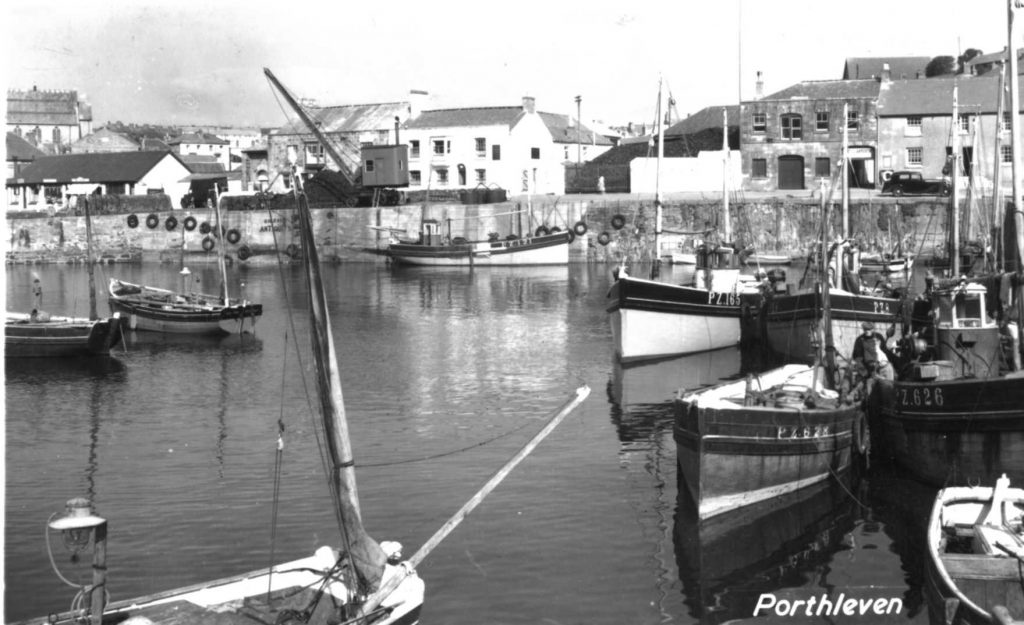
– if somewhat out of focus.
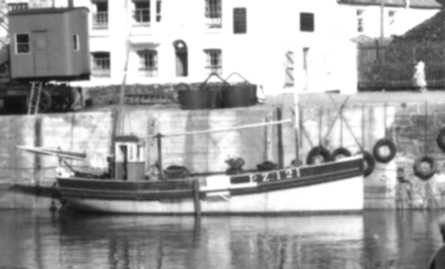
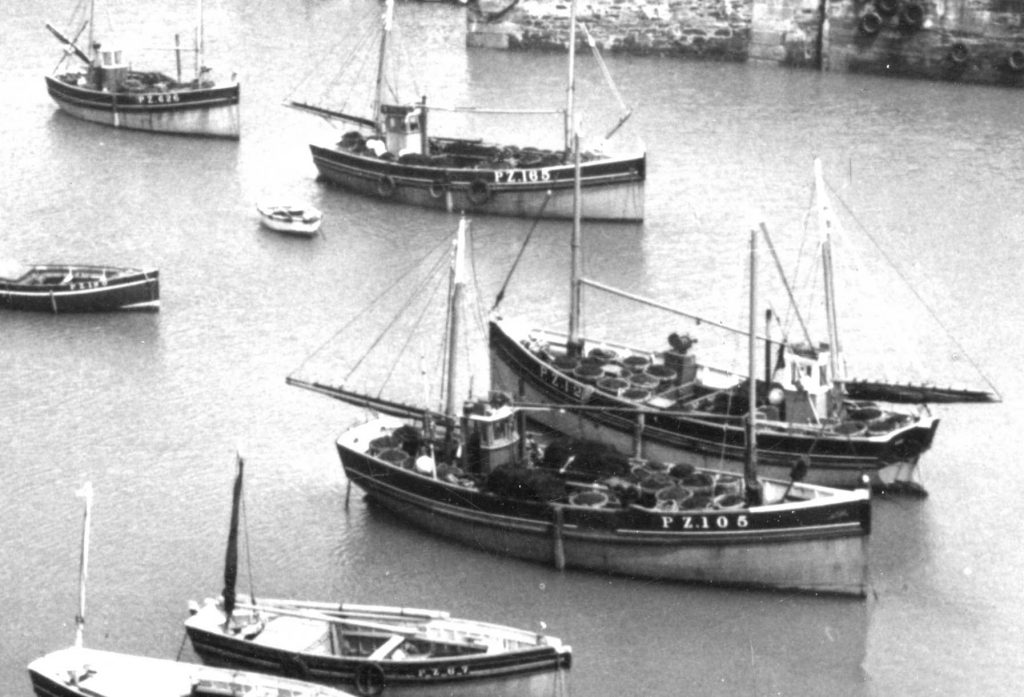
In the above photos she was fitted out for long-line fishing, note her twin-wheeled line-hauler, mounted on a box on the starboard rail. But as we have seen, she also worked drift nets for pilchards in the season – more so after the war.
In the post-war decade there was a concerted drive to boost the Cornish pilchard fisheries, heralded with the establishment of the Cornish Canners Ltd., in January 1946. However, the markets were still unstable, and new machinery was hard to come-by. So it was not until May 1949 that their canning factory at Newlyn eventually went into production.
Opened yesterday, Cornish Canners Ltd., have installed enough machinery for 350 stones of pilchards a day. When further plant they are still awaiting arrives they will be able to cope with up to 1,000 stones. For the present they will employ between 15 to 20 hands.
Western Morning News, Thursday 19th May 1949
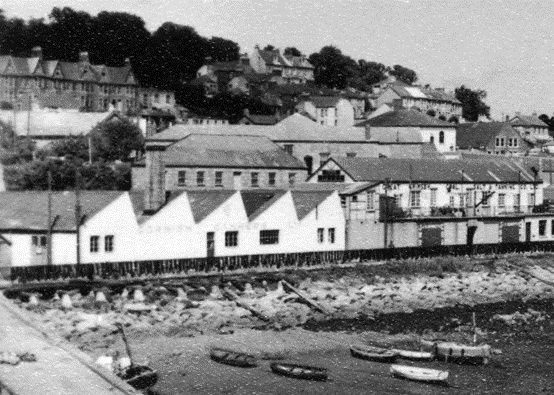
Unfortunately they got off to a shaky start, with inadequate fresh fish supplies at first, feast or famine was all too often the state of affairs in the pilchard fishery.
About 100 boats from Newlyn, Mousehole, St. Ives, Mevagissey, and Looe will take part in the autumn pilchard fishing season.
Because of the uncertainty of the Italian market it is expected that many boats will carry on long-lining as long as possible.
Three boats from Mount’s Bay, four from Looe, and one from Mevagissey will be using the ting-netting method this year.
In Mount’s Bay about 15 boats have been engaged in the summer pilchard season, and these have been supplying the ling-liners with bait, and the rest of their catches are going to thye canners.
The Newlyn canning factory, which had to suspend work earlier in the season because of the lack of fish, has been operating for several weeks.
Mr. G. C. Gould-Porter, chairman of the Federation of English and Welsh Inshore Fishermen, said yesterday: “Although the Italian market is very bad and it does not seem likely at the moment that many pilchards will be cured for export this season, it must not be thought the position is completely hopeless.
If the Cornish and Devon canners are working to capacity about 6,000 stone of pilchards a day can be taken.
With a limited fleet this year they will be able to cope with normal landings. If however the landings are heavy, some other means than curing for export will have to be found.
Western Morning News, Saturday 1st October 1949
It was during this period after the war that the Biddy came into the hands of Porthleven fish-merchant and curer William Strike Pawlyn, but only for a few months – possibly as security for a loan to the Russell’s.3 During this time J. G. Russell was her skipper, and she was sold on to Arthur Russell, of Unity Road, Porthleven, who became her registered owner on August 1st 1946, and then L. Russell became her fourth skipper. She continued working out of Porthleven and Newlyn until June 1969.
I have not looked into her post-war fishing records in any detail, but on one occasion she was full to the gunn’ls with pilchards when she was photographed easing into a quayside berth, inside of the Pioneer.
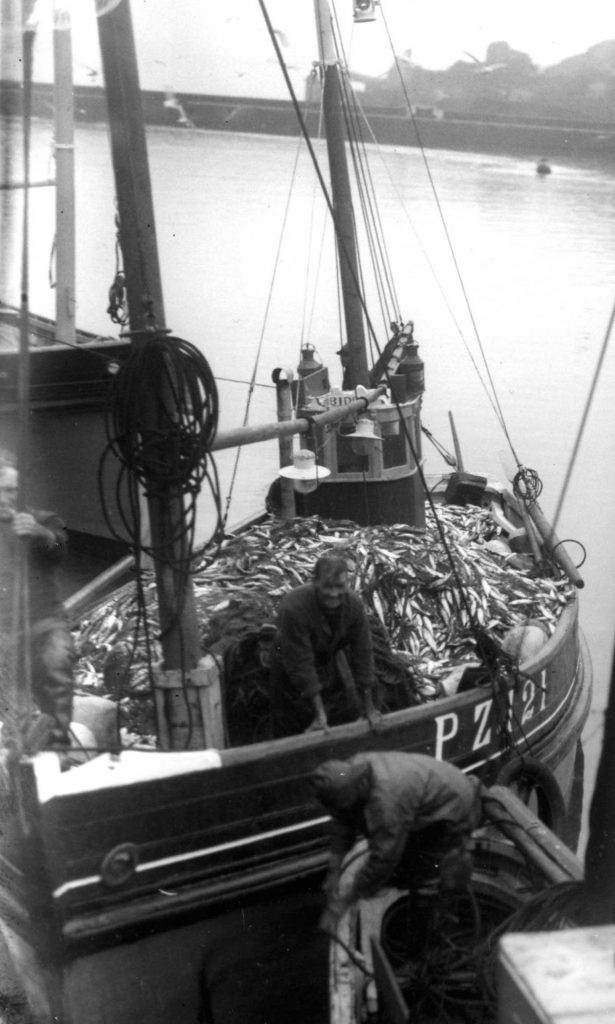
In June 1969 the Biddy was acquired by Archibald Morrison Hay, of 11, Mowbray Road, Fleetwood, and worked out of that port, where an E. Falcner became her skipper.4 Hay moved houses twice during the next twenty years or so, and while the boat notionally worked out of Fleetwood, her port of registry remained Penzance throughout.
How active she was as a fishing boat during this later period is not known, but she appears to have been transferred to the new computerised registration scheme, as on 22nd April 1989, the office copy of her old register was stamped.
Cancelled under MSA 1988
I have not yet tried to trace her beyond 1988.
Insurance
Initially the Breadwinner / Biddy does not appear to have been on the books of the Cornish Fishing Vessels Insurance Society [whose first minute-book Morgan Hosking kindly let me borrow, back in the 1970s]. However, on October 19th 1946, shortly after Arthur Russell acquired her, the Society accepted Biddy in the value of £1,000. At the same meeting the committee agreed to cover the Renovelle [W. S. Capps, Newlyn, £1,500]; Ayronwen [W. Blewett, Newlyn, £375]; Renown [T. W. Thorpe, Mousehole, £200] and Pioneer [H. Hendy, Penzance, £1,000]. In the years following there was a steady trickle of claims.5
In April 1950 a claim was made for a new mizen mast, but as this was not costed, it does not seem to have been allowed by the society. A claim for damage repairs costing £12 10s. was considered in March 1951, but again there is no note that any payment was approved. In November 1952 payment was approved for repairs costing £23 8s, carried out by Porthleven shipwright W. S. Oliver, and a further for £10 6s, for a new mizen mast, was considered. Wear and tear were taking their toll, and in March 1954 a claim for bulwark repairs costing £25 was approved.
In 1956 the Biddy received ‘extensive damage sustained while lying beside Custom House Quay, Falmouth.’ The claim now under consideration being for £39 18s 6d. The cause of the damage was not recorded, but there was a similar claim for damage to Maid Marion. Payment to W. S. Oliver, on account of repairs to the Biddy, of £38 13s 6d, was approved in January 1957 – and £9 5s. 6d. for the Maid Marion. I have no information on any further claims, the minute book that I had borrowed from Morgan Hosking recording that they had been ‘transferred to new book – 27.8.1960.’ Which I was not allowed to review as it was still current in the 1970s, when I made the above notes.
| Registered dimensions | 03/07/1925 | 14/10/1926 | 16/03/1928 | 26/07/1937 | 04/02/1976 |
|---|---|---|---|---|---|
| Length of Keel ft. | 35.00 | 35.00 | 35.00 | 35.00 | 35.00 |
| Length ft. | 40.2 | 40.2 | 40.2 | 40.2 | 39.1 |
| Breadth ft. | 13.1 | 13.1 | 13.1 | 13.1 | 13.1 |
| Depth ft. | 5.0 | 5.0 | 5.0 | 5.0 | 5.0 |
| Tonnage – tons gross | 20.15 | 20.15 | 12.25 | 12.25 | 11.52 |
| Tonnage – tons net reg. | 20.15 | 20.15 | 12.25 | 12.25 | 11.52 |
| Number of Crew: men | 4 | 4 | 4 | 4 | 4 |
| Number of crew: boys | – | – | – | – | – |
Tony Pawlyn
14 September 2020
